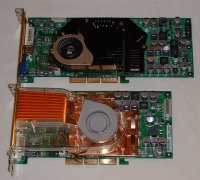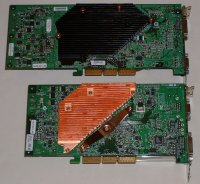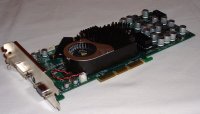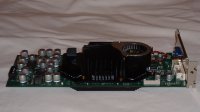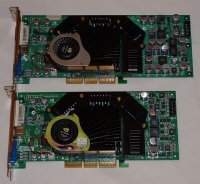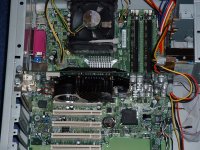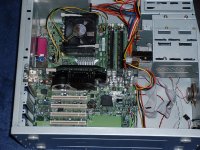The BoardNow that we've taken a look at the details and new features of the NV35 chip we'll take a look at the specifics of the reference board level implementation in its GeForce FX 5900 Ultra form.
Here we can see that the 5900 Ultra features a core clock rate of 450MHz and a memory speed of 425MHZ, which is both decreased from the 5800 Ultra's clocks of 500/500 respectively. Obviously, the doubling of the memory bus width more than offsets the difference in memory clock speed, with 5900 Ultra having 27GB of bandwidth in comparison to 5800 Ultra's 16GB. And the difference in fill-rate, due to the lower core speed, should be overcome in high bandwidth utilisation situations thanks to the increased bus width.
As we can see from the images above, the 5900 Ultra board is considerably different from the 5800 Ultra board. The most notable difference is the removal of the heat pipe/fan mechanism of the 5800 Ultra that generated a considerable level of criticism for the noise it produced. 5900's cooling system is still reliant on two system slots, but it's considerably quieter than 5800's. The 5900 still features the Silent Running mode, whereby the fan spins down in non-intensive 2D operations, and goes to full speed in 3D operations - the level of noise is a little greater than that of more conventional single fan / single slot solutions, but it is certainly less likely to cause any distraction than 5800 Ultra does. The memory arrangement is also very different from the 5800 Ultra to facilitate both a 256-bit bus and the 16 RAM chips required for 256MB. The memory placement bears some resemblance to Matrox’s Parhelia, with the chips arching around the core, which means that the trace lines from all the memory are kept at a minimum level which should aid high clock rates. The memory on the front of the boar also features larger heatsinks, as well as a large heat spreader across all the chips on the underside of the board. The reference board features the relatively standard output functionality of a VGA, DVI and TV-Out. As we’ve seen from all of this year's high end boards, and down to NVIDIA’s low end, the 5900 Ultra also has a molex power supply socket to provide it all the power it needs to operate directly from the system PSU.
The reference board we're are looking at today is a relatively early version, and NVIDIA have since managed to consolidate a number of the power regulation components on to a fewer number of components, thus shrinking the overall board size. The image above shows a later reference based board, as sold by Creative in this instance, and it is somewhat shorter than the earlier version.
|
|
||||||||||||||||||||||||||||||||
NVIDIA GeForce FX 5900 Ultra - Page 3
Published on 11th Aug 2003, written by Dave Baumann for Consumer Graphics - Last updated: 4th Jul 2007

